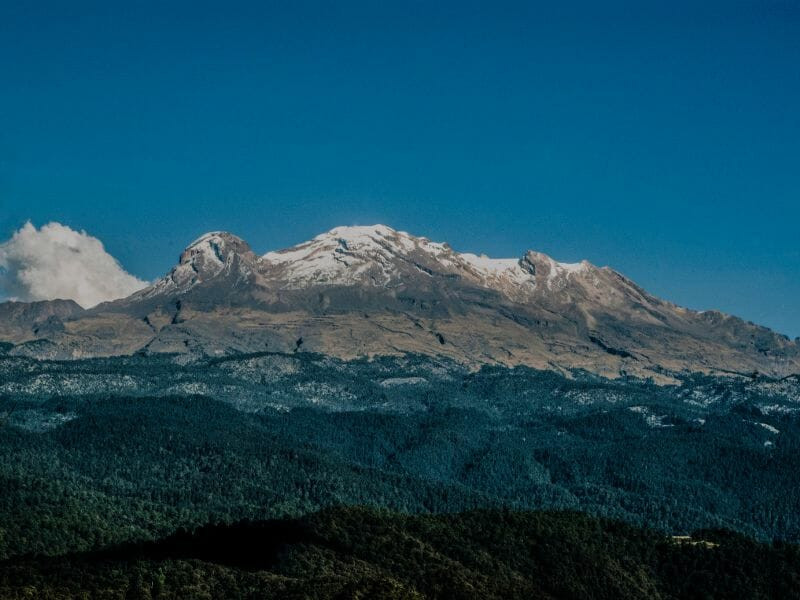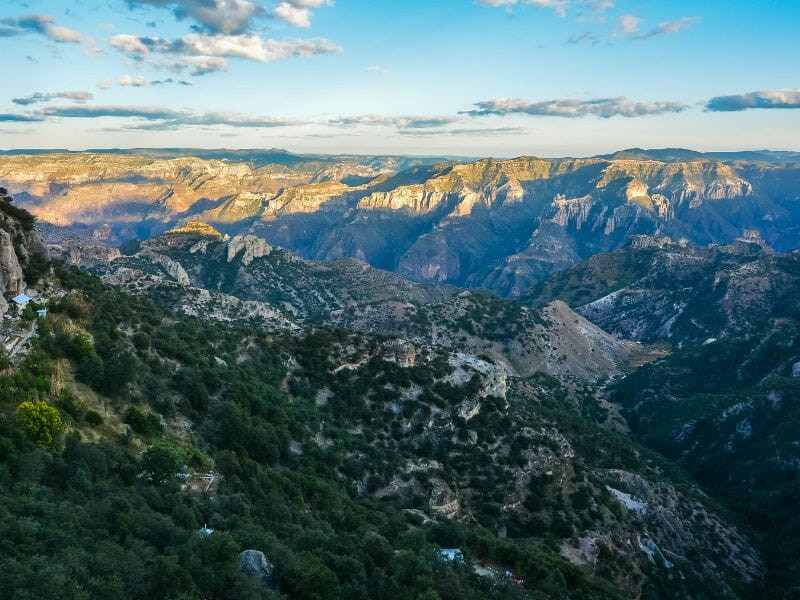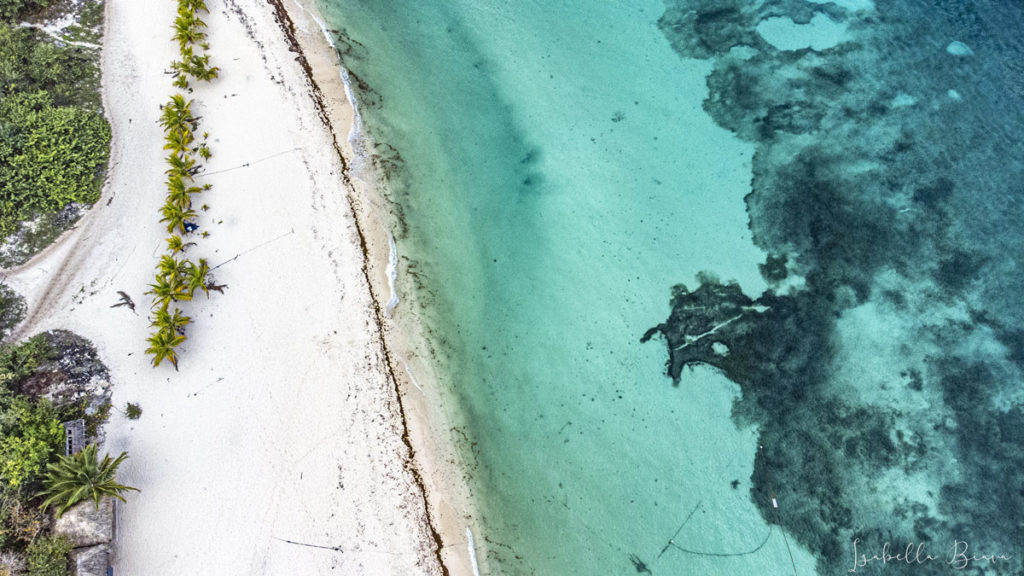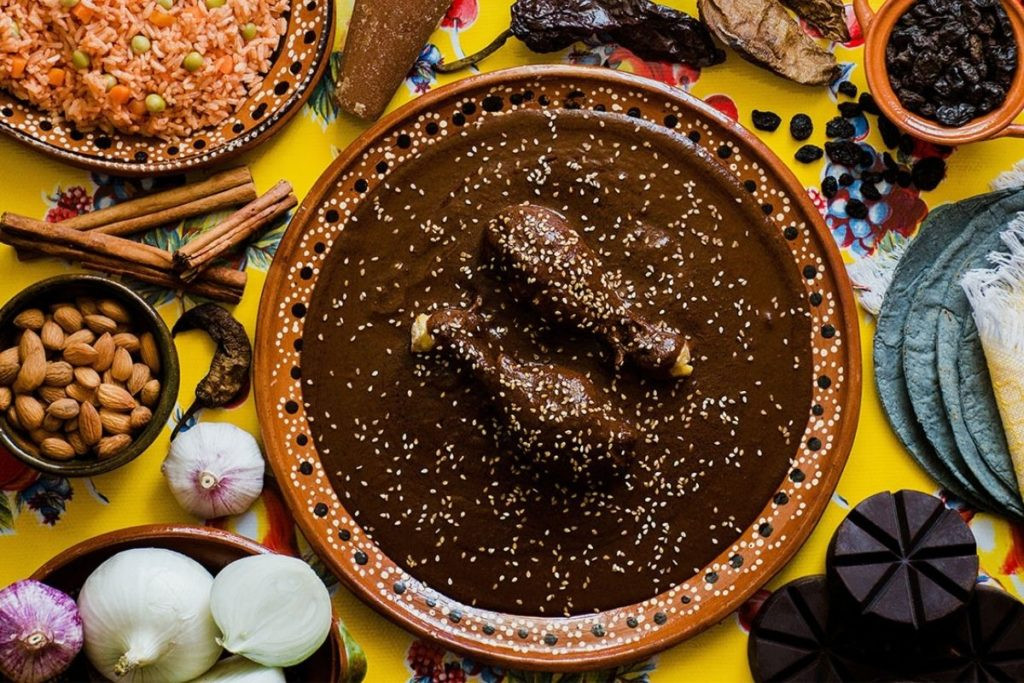Does Mexico Ever Get Snow? Absolutely! While Mexico is often thought of as a tropical paradise, certain regions experience snowfall, especially during the winter months. Gaymexico.net is here to guide you through these winter wonderlands, showcasing the diverse landscapes and unexpected snowy escapes Mexico has to offer. Discover LGBTQ+-friendly destinations with unique winter experiences and plan your trip to experience the beauty of a Mexican winter.
1. Understanding Mexico’s Diverse Climate
Mexico’s climate is incredibly varied due to its size and topography, ranging from tropical rainforests to arid deserts and high-altitude mountains. This means that while some areas enjoy year-round sunshine, others see freezing temperatures and snowfall.
1.1 Factors Influencing Snowfall in Mexico
Several factors contribute to snowfall in Mexico:
- Altitude: Higher elevations experience colder temperatures, increasing the likelihood of snow.
- Latitude: Northern regions, being further from the equator, are generally cooler.
- Proximity to Mountain Ranges: Mountain ranges like the Sierra Madre Oriental and Sierra Madre Occidental trap moisture and create cooler microclimates.
- Winter Storms: Cold fronts from North America can bring freezing temperatures and snowfall to northern and mountainous areas.
2. Where Does It Snow in Mexico? Top Snowy Destinations
While snow isn’t widespread, certain regions in Mexico transform into winter wonderlands during the colder months. These destinations offer unique experiences for travelers seeking a different side of Mexico.
2.1 Northern Mexico’s Winter Havens
The northern states are the most likely to see snow, thanks to their higher latitudes and mountainous terrain.
- Chihuahua: The Copper Canyon, a network of canyons larger than the Grand Canyon, often sees snowfall in the winter. The El Chepe train offers stunning views of the snow-covered landscapes.
- Coahuila: Arteaga, known as the “Switzerland of Mexico,” is a charming town nestled in the Sierra Madre Oriental mountains, offering skiing and snow tubing opportunities.
- Durango: Mexiquillo, a beautiful forest with waterfalls and stunning landscapes, is a prime spot for experiencing Mexican snowfall.
2.2 Central Mexico’s High-Altitude Peaks
Several volcanoes and high-altitude areas in central Mexico also experience snowfall.
- Nevado de Toluca (State of Mexico): This extinct volcano offers hiking and mountaineering opportunities, with its peaks often covered in snow during winter.
- Iztaccihuatl (Puebla/State of Mexico): The third tallest mountain in Mexico, Iztaccihuatl, also known as the “Sleeping Woman,” is a popular spot for mountaineers.
- Pico de Orizaba (Veracruz/Puebla): The highest mountain in Mexico and the highest volcano in North America, Pico de Orizaba is a challenging but rewarding climb for experienced mountaineers.
- La Malinche (Tlaxcala/Puebla): This volcano offers a less challenging climb than Pico de Orizaba, making it a good training ground for aspiring mountaineers.
3. Planning Your Snowy Getaway: Tips and Considerations
Planning a trip to experience snow in Mexico requires some preparation. Here are some tips to ensure a safe and enjoyable adventure:
3.1 Best Time to Visit for Snowfall
The winter months, from December to February, are the most likely to see snowfall in Mexico. Temperatures are at their lowest during this period, increasing the chances of snow accumulation.
3.2 What to Pack for a Winter Trip to Mexico
Even though you’re traveling to Mexico, packing for snow is essential if you’re heading to the northern or high-altitude regions.
- Warm Clothing: Layers are key! Pack thermal underwear, fleece jackets, and a waterproof outer layer.
- Winter Accessories: Don’t forget hats, gloves, scarves, and warm socks.
- Sturdy Footwear: Waterproof hiking boots with good traction are essential for navigating snowy or icy terrain.
- Sun Protection: Even in winter, the sun can be strong at high altitudes. Pack sunscreen, sunglasses, and lip balm.
3.3 Safety Precautions for Mountain Travel
If you’re planning to hike or climb in snowy areas, take these safety precautions:
- Acclimatize to the Altitude: Spend a few days at a lower altitude before ascending to higher elevations to avoid altitude sickness.
- Check the Weather Forecast: Be aware of potential snowstorms or extreme weather conditions.
- Hire a Local Guide: Experienced guides can provide valuable insights and ensure your safety.
- Bring Plenty of Food and Water: Stay hydrated and energized during your trek.
- Let Someone Know Your Plans: Inform someone of your itinerary and expected return time.
4. LGBTQ+ Considerations for Traveling to Snowy Mexico
While Mexico is generally becoming more LGBTQ+-friendly, it’s essential to be aware of local customs and attitudes, especially in smaller towns and rural areas.
4.1 Researching LGBTQ+-Friendly Destinations
Before you go, research the LGBTQ+-friendliness of your chosen destination. Cities like Arteaga, with a tourism focus, are generally more accepting.
4.2 Public Displays of Affection
While major cities are generally accepting, be mindful of public displays of affection in more conservative areas. It’s always best to err on the side of caution.
4.3 Connecting with Local LGBTQ+ Communities
Consider connecting with local LGBTQ+ organizations or community centers for information and support. They can provide valuable insights into the local culture and resources available.
5. Featured Snowy Destinations in Detail
Let’s explore some of the top destinations for experiencing snow in Mexico, highlighting their unique attractions and activities.
5.1 Mexiquillo, Durango: A Forest of Ice and Wonder
Located northeast of Mexico City, Mexiquillo is a stunning forest known for its waterfalls and unique rock formations.
 Snow-covered forest in Mexiquillo, Durango
Snow-covered forest in Mexiquillo, Durango
Alt text: A snow-covered forest in Mexiquillo, Durango, showcasing the winter wonderland with tall trees and a light dusting of snow on the ground.
- Activities: Hiking, exploring waterfalls, and enjoying the snow-covered landscapes.
- Accessibility: Take a bus from La Cuidad, but bring your own food as there are limited dining options.
- Accommodation: Cabanas are available for lodging.
- Safety: Generally safe, but follow common-sense rules.
5.2 Sombrerete, Zacatecas: Colonial Charm in a Winter Setting
Sombrerete, a UNESCO World Heritage Site, is a historic town known for its colonial architecture and monuments.
- Activities: Exploring colonial buildings, visiting Sierra de Organos National Park, and enjoying the snow-covered streets.
- Accommodation: Plenty of rooms and lodging options available.
- Safety: Quite safe for tourists.
5.3 Arteaga, Coahuila: The Switzerland of Mexico
Arteaga is a scenic town nestled in the Sierra Madre Oriental mountains, offering a European-like winter experience.
- Activities: Skiing, snow tubing, and exploring the town’s charming streets.
- Accommodation: Great hotel options to choose from.
- Dining: Good restaurants are available.
- Safety: Safe for a memorable trip.
5.4 Copper Canyon, Chihuahua: A Grand Canyon in White
The Copper Canyon is a network of canyons larger than the Grand Canyon, offering breathtaking views, especially when covered in snow.
 Snow-covered Copper Canyon
Snow-covered Copper Canyon
Alt text: Panoramic view of the Copper Canyon covered in snow, showcasing the vastness and beauty of the canyon during winter.
- Activities: Exploring cities and towns, horseback riding, biking, hiking, and riding the El Chepe train.
- Accommodation: Hotels perched on the rim of the canyon offer stunning views.
- Culture: Home to the Rarámuri people, known for their long-distance running abilities.
5.5 Nevado de Toluca, State of Mexico: Hiking Among Volcano Rabbits
Nevado de Toluca is an extinct volcano with two lagoons in its crater, offering unique hiking and mountaineering experiences.
- Activities: Hiking, mountaineering, mountain biking, rappelling, and climbing.
- Wildlife: Keep an eye out for the rare volcano rabbits.
- Altitude: Be aware of altitude sickness and acclimatize before hiking.
5.6 Iztaccihuatl: The Sleeping Woman
Iztaccihuatl, the third tallest mountain in Mexico, offers a challenging but rewarding climb for mountaineers.
- Location: Izta-Popo Zoquiapan National Park, near Mexico City.
- Best Time to Visit: December to February for less rain and colder temperatures.
- Activity: Guided hiking tours are available from Mexico City.
5.7 Pico de Orizaba: Reaching for the Stars
Pico de Orizaba, the highest mountain in Mexico, is a popular destination for extreme adventure lovers.
- Activity: Hiking, mountaineering, and climbing the highest volcanic summit in North America.
- Challenge: The world’s most pronounced volcanic summit after Mount Kilimanjaro.
- Recommendation: Book a tour with a professional company that prioritizes safety.
5.8 La Malinche (Malintzin): Training Grounds for Mountaineers
La Malinche is a volcano that offers a less challenging climb, making it a good training ground for aspiring mountaineers.
- Location: Between the Tlaxcala and Puebla states of Mexico.
- Elevation: Around 14,500 feet above sea level.
- Preparation: Crampons and axes may be needed after recent snowfall.
5.9 Popocatépetl: An Active Adventure
Popocatépetl is an active volcano, offering a unique and potentially risky adventure.
- Location: Near Mexico City.
- Recommendation: Visit with a reputable tour company that provides professional guides.
- Safety: Monitor volcanic activity and check the weather forecast before visiting.
6. Gaymexico.net: Your Guide to LGBTQ+ Travel in Mexico
Gaymexico.net is your ultimate resource for planning safe, fun, and informed LGBTQ+ travel experiences in Mexico.
6.1 Discovering LGBTQ+-Friendly Destinations
Find detailed guides to LGBTQ+-friendly cities and regions, including recommendations for accommodations, nightlife, and cultural attractions.
6.2 Staying Up-to-Date on LGBTQ+ News and Events
Stay informed about the latest LGBTQ+ news, events, and legal updates in Mexico. We provide accurate and reliable information to help you navigate your travels with confidence.
6.3 Connecting with the LGBTQ+ Community in Mexico
Connect with local LGBTQ+ communities and organizations for insider tips, support, and opportunities to engage with the culture.
6.4 Planning Your Trip with Confidence
Access our comprehensive travel resources, including safety tips, cultural insights, and practical advice for LGBTQ+ travelers.
7. Frequently Asked Questions About Snow in Mexico
Let’s address some common questions about experiencing snow in Mexico.
7.1 Does Mexico ever snow?
Yes, Mexico does get snow, but it’s limited to certain areas, primarily the northern regions and high-altitude mountains.
7.2 What is the coldest place in Mexico?
Apizaco in the Tlaxcala state is considered the coldest place in Mexico, with an average annual temperature of 62.76ºF.
7.3 Does it snow in Mexico at Christmas?
It can snow in Mexico at Christmas, but only in some parts of the country, mainly the northern states.
7.4 Does Mexico have winter?
Yes, Mexico has a winter season that runs from December to February, with all four distinct seasons of the year.
7.5 What is the coldest state in Mexico?
The coldest state in Mexico is Tlaxcala State, located east of Mexico City in Central Mexico.
7.6 Does it freeze in Mexico?
Yes, but only rarely. The temperature drops below freezing point in some of the coldest places in the northern states.
7.7 Does it snow in Mexico City?
No, it almost never snows in Mexico City. Snowfall is extremely rare.
7.8 Does Mexico get cold at night?
This depends on the time of year and the location. Nights can get chilly, especially during the fall, winter, and spring seasons.
7.9 Where is the nicest weather in Mexico?
Mexico beach destinations such as Cancun, Tulum, Cabo, La Paz, Puerto Vallarta, and Sayulita are among the top destinations where you can find an eternal summer.
7.10 What month is best to go to Mexico?
This depends on your preferences. The high season (December through March) is great for beach vacations, while the low season (June through September) offers budget-friendly travel.
8. Beyond Snow: Exploring Mexico’s Diverse Attractions
While snow might be a surprising aspect of Mexico, the country offers a wealth of attractions beyond its winter wonderlands.
8.1 Ancient Mayan Ruins
Explore the fascinating ruins of ancient Mayan cities like Chichen Itza, Tulum, and Palenque.
8.2 Beautiful Beaches
Relax on the stunning beaches of Cancun, Playa del Carmen, and Puerto Vallarta.
 Cozumel Beach Aerial View
Cozumel Beach Aerial View
Alt text: Aerial view of Cozumel Beach, showcasing the turquoise waters and white sandy beaches of the popular tourist destination.
8.3 Natural Scenery
Discover the breathtaking landscapes of the Copper Canyon, the cenotes of the Yucatan Peninsula, and the waterfalls of Chiapas.
8.4 World-Renowned Cuisine
Savor the flavors of Mexican cuisine, from street tacos to gourmet dishes like mole.
8.5 Vibrant Culture
Experience the rich culture of Mexico through its music, dance, art, and traditions.
9. Mole Sauce: Mexico’s National Dish
Mole sauce from Oaxaca is widely considered Mexico’s national dish, though Chile en Nogada from Puebla is another strong contender. This complex sauce, with its many variations, is a true culinary masterpiece.
 Mole Sauce from Oaxaca
Mole Sauce from Oaxaca
Alt text: Close-up of Mole sauce from Oaxaca, highlighting the rich, dark color and texture of this traditional Mexican dish.
10. Safety Tips for Travelers
Mexico is generally safe to visit, but it’s important to be aware of your surroundings and take precautions. Research your destination, avoid unsafe areas, and be mindful of your belongings.
 Rental Car on the Road
Rental Car on the Road
Alt text: A rental car driving on a scenic road in Hidalgo, Mexico, illustrating the freedom and adventure of exploring the country by car.
11. Plan Your Adventure with Gaymexico.net Today!
Ready to explore the winter wonders of Mexico and discover LGBTQ+-friendly destinations? Visit Gaymexico.net for detailed guides, travel tips, and community connections. Start planning your unforgettable Mexican adventure today!
Address: 3255 Wilshire Blvd, Los Angeles, CA 90010, United States
Phone: +1 (213) 380-2177
Website: gaymexico.net
12. Exploring Mexico: A Land of Endless Possibilities
Mexico is a country of endless possibilities, offering a diverse range of experiences for every traveler. Whether you’re seeking snowy adventures, beach relaxation, cultural immersion, or culinary delights, Mexico has something to offer.
12.1 Cultural Experiences
Immerse yourself in Mexico’s rich culture by visiting historical sites, attending festivals, and learning about local traditions.
12.2 Culinary Delights
Indulge in Mexico’s world-renowned cuisine, from street food to gourmet dining. Take a cooking class and learn to prepare authentic Mexican dishes.
12.3 Adventure Activities
From hiking and climbing to surfing and snorkeling, Mexico offers a wide range of adventure activities for thrill-seekers.
12.4 Relaxation and Wellness
Unwind and rejuvenate at Mexico’s luxurious resorts and spas. Practice yoga on the beach, indulge in a massage, and soak up the sun.
13. Conclusion: Embrace the Unexpected in Mexico
Mexico is a country full of surprises, and experiencing snow in this tropical paradise is just one of them. Embrace the unexpected, explore the diverse landscapes, and create unforgettable memories in this vibrant and welcoming country. With Gaymexico.net as your guide, you can plan a safe, fun, and enriching LGBTQ+ travel experience that celebrates the beauty and diversity of Mexico. So, pack your bags, grab your winter gear, and get ready to discover the snowy side of Mexico!
14. FAQ About Snow in Mexico for LGBTQ+ Travelers
1. Is Mexico safe for LGBTQ+ travelers seeking snow destinations?
Yes, many areas are safe and welcoming. Focus on tourist-friendly locations and research local LGBTQ+ resources.
2. Which snowy destinations in Mexico are most LGBTQ+-friendly?
Larger cities and tourist hubs near snowy areas tend to be more accepting. Research specific locations beforehand.
3. Are there LGBTQ+ events or communities near snowy regions in Mexico?
While less common than in major cities, some smaller communities may exist. Online research and networking are key.
4. What safety precautions should LGBTQ+ travelers take in snowy regions?
Exercise caution with public displays of affection, especially in conservative areas. Be aware of your surroundings.
5. What resources does Gaymexico.net offer for planning a snowy trip?
gaymexico.net provides destination guides, safety tips, and community connections to help plan your trip.
6. How can I find LGBTQ+-friendly accommodations near snowy areas?
Use online travel platforms and search for inclusive hotels or guesthouses in your chosen destination.
7. What cultural norms should I be aware of as an LGBTQ+ traveler in these regions?
Research local customs and traditions. Respectful behavior is always appreciated.
8. Are there any specific laws or regulations I should know as an LGBTQ+ traveler?
While Mexico has made progress, laws vary by state. Stay informed about local regulations.
9. What emergency resources are available for LGBTQ+ travelers in Mexico?
Know the contact information for local police, hospitals, and LGBTQ+ organizations in case of emergencies.
10. How can I connect with other LGBTQ+ travelers who have visited these regions?
Join online forums or social media groups to connect with experienced travelers and gather insights.